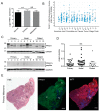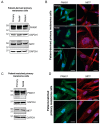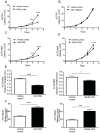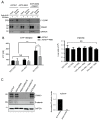Inhibition of Pannexin 1 Reduces the Tumorigenic Properties of Human Melanoma Cells
- PMID: 30654593
- PMCID: PMC6356688
- DOI: 10.3390/cancers11010102
Inhibition of Pannexin 1 Reduces the Tumorigenic Properties of Human Melanoma Cells
Abstract
Pannexin 1 (PANX1) is a channel-forming glycoprotein expressed in many tissues including the skin. PANX1 channels allow the passage of ions and molecules up to 1 kDa, including ATP and other metabolites. In this study, we show that PANX1 is highly expressed in human melanoma tumors at all stages of disease progression, as well as in patient-derived cells and established melanoma cell lines. Reducing PANX1 protein levels using shRNA or inhibiting channel function with the channel blockers, carbenoxolone (CBX) and probenecid (PBN), significantly decreased cell growth and migration, and increased melanin production in A375-P and A375-MA2 cell lines. Further, treatment of A375-MA2 tumors in chicken embryo xenografts with CBX or PBN significantly reduced melanoma tumor weight and invasiveness. Blocking PANX1 channels with PBN reduced ATP release in A375-P cells, suggesting a potential role for PANX1 in purinergic signaling of melanoma cells. In addition, cell-surface biotinylation assays indicate that there is an intracellular pool of PANX1 in melanoma cells. PANX1 likely modulates signaling through the Wnt/β-catenin pathway, because β-catenin levels were significantly decreased upon PANX1 silencing. Collectively, our findings identify a role for PANX1 in controlling growth and tumorigenic properties of melanoma cells contributing to signaling pathways that modulate melanoma progression.
Keywords: ATP; Chick-CAM; PANX1; Wnt; carbenoxolone; melanoma; pannexin; patient-derived cells; probenecid; tumor growth; xenografts; β-catenin.
Conflict of interest statement
The authors declare no conflict of interest. The funders had no role in the design of the study; in the collection, analyses, or interpretation of data; in the writing of the manuscript, or in the decision to publish the results.
Figures







Similar articles
-
Inhibition of PANX1 Channels Reduces the Malignant Properties of Human High-Risk Neuroblastoma.J Cancer. 2023 Mar 13;14(5):689-706. doi: 10.7150/jca.79552. eCollection 2023. J Cancer. 2023. PMID: 37056395 Free PMC article.
-
Pannexin 1 binds β-catenin to modulate melanoma cell growth and metabolism.J Biol Chem. 2021 Jan-Jun;296:100478. doi: 10.1016/j.jbc.2021.100478. Epub 2021 Feb 26. J Biol Chem. 2021. PMID: 33647315 Free PMC article.
-
Role of pannexin 1 in Clostridium perfringens beta-toxin-caused cell death.Biochim Biophys Acta. 2016 Dec;1858(12):3150-3156. doi: 10.1016/j.bbamem.2016.10.003. Epub 2016 Oct 5. Biochim Biophys Acta. 2016. PMID: 27720686
-
Pannexin1 channels-a potential therapeutic target in inflammation.Front Cell Dev Biol. 2022 Nov 9;10:1020826. doi: 10.3389/fcell.2022.1020826. eCollection 2022. Front Cell Dev Biol. 2022. PMID: 36438559 Free PMC article. Review.
-
Skin in the game: pannexin channels in healthy and cancerous skin.Biochem J. 2023 Dec 13;480(23):1929-1949. doi: 10.1042/BCJ20230176. Biochem J. 2023. PMID: 38038973 Review.
Cited by
-
Modifying the Tumour Microenvironment: Challenges and Future Perspectives for Anticancer Plasma Treatments.Cancers (Basel). 2019 Dec 2;11(12):1920. doi: 10.3390/cancers11121920. Cancers (Basel). 2019. PMID: 31810265 Free PMC article. Review.
-
A metastasis-associated pannexin-1 mutant (Panx11-89) forms a minimalist ATP release channel.FEBS J. 2025 Jul;292(13):3378-3396. doi: 10.1111/febs.70060. Epub 2025 Mar 14. FEBS J. 2025. PMID: 40087867 Free PMC article.
-
Pannexin 1 and pannexin 3 differentially regulate the cancer cell properties of cutaneous squamous cell carcinoma.J Physiol. 2025 Aug;603(15):4409-4432. doi: 10.1113/JP286172. Epub 2024 Nov 19. J Physiol. 2025. PMID: 39560179 Free PMC article.
-
Apically localized PANX1 impacts neuroepithelial expansion in human cerebral organoids.Cell Death Discov. 2024 Jan 11;10(1):22. doi: 10.1038/s41420-023-01774-7. Cell Death Discov. 2024. PMID: 38212304 Free PMC article.
-
Investigation of miR-93-5p and its effect on the radiosensitivity of breast cancer.Cell Cycle. 2021 Jun;20(12):1173-1180. doi: 10.1080/15384101.2021.1930356. Epub 2021 May 24. Cell Cycle. 2021. PMID: 34024254 Free PMC article.
References
-
- Penuela S., Bhalla R., Gong X.Q., Cowan K.N., Celetti S.J., Cowan B.J., Bai D., Shao Q., Laird D.W. Pannexin 1 and pannexin 3 are glycoproteins that exhibit many distinct characteristics from the connexin family of gap junction proteins. J. Cell Sci. 2007;120:3772–3783. doi: 10.1242/jcs.009514. - DOI - PubMed
Grants and funding
LinkOut - more resources
Full Text Sources

